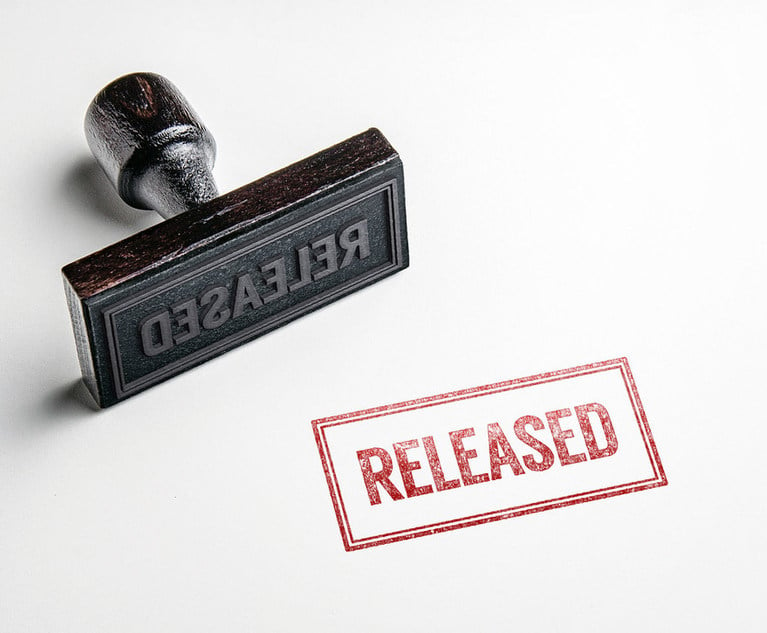Entire Controversy Doctrine Lives On in Legal Malpractice Litigation
The Supreme Court reminds us that we all should be aware of the doctrine and its potential application in the context of legal malpractice.
May 19, 2019 at 10:00 AM
3 minute read
 Shutterstock
Shutterstock
Many seasoned attorneys in practice today were not yet admitted to the bar when the Supreme Court held, in 1995, that the entire controversy doctrine (ECD) barred a legal malpractice action because it wasn't commenced during the very proceeding in which the attorney represented the client and committed the alleged malpractice. If you had been admitted when Circle Chevrolet was decided, see Circle Chevrolet Co, v Giordano, Halleran & Ciesla, 142 N.J. 280 (1995), you will never forget the consternation it caused. But the concerns dissipated just two years later when the court decided Olds v Donnelly, 150 N.J. 424 (1997), which held that the ECD did not require a client to file the malpractice action in the underlying action in which the attorney represented the client. The ECD otherwise remained an important part of our procedural jurisprudence designed to avoid piecemeal litigation and unnecessary resources, while promoting judicial efficiency and reduction of delay in adjudicating cases.
The principle as it applies to legal malpractice actions is not dead, however, and the recent Supreme Court opinion in Dimitrakopoulos v Borrus, Golden, Foley, Vignuolo, Hyman & Stahl, decided on March 7, 2019, reminds us of the need to remain vigilant from the point of view of both client and practitioner.
There, former clients filed a malpractice case against former counsel over three years following conclusion of the attorneys' collection action for unpaid legal fees. The court concluded that a collection action brought by a law firm against the former clients is not the type of “underlying action” that excepts application of the doctrine. It “does not raise the privilege and loyalty concerns that warranted the exception to the entire controversy doctrine recognized in Olds.” But the court emphasized that “[i]n appropriate settings, a court may apply the [ECD] to preclude a legal malpractice claim that a client has declined to assert in the attorney's action to collect unpaid legal fees.” The client would have to have known, or reasonably know, “of the claim during the pendency of the collection action,” and the collection action would have to be found to constitute a forum that provided “a fair and reasonable opportunity to have fully litigated” the malpractice claim. As the collection action was not an “underlying action” but the record in Borrus did not indicate when the malpractice action accrued and if the clients therefore had a “fair and reasonable opportunity” to have litigated the malpractice claim in the collection action, the Supreme Court remanded for further proceedings.
On remand, the trial court has to consider when the malpractice cause of action accrued and whether there was a fair and reasonable opportunity to have raised and litigated it in the collection action. A Lopez hearing as to discovery of the alleged malpractice and claim of waiver of the malpractice action must be considered. We are reminded by the court that each case is fact specific, but we all should be generally aware of the ECD and its potential application even in the context of legal malpractice.
This content has been archived. It is available through our partners, LexisNexis® and Bloomberg Law.
To view this content, please continue to their sites.
Not a Lexis Subscriber?
Subscribe Now
Not a Bloomberg Law Subscriber?
Subscribe Now
NOT FOR REPRINT
© 2025 ALM Global, LLC, All Rights Reserved. Request academic re-use from www.copyright.com. All other uses, submit a request to [email protected]. For more information visit Asset & Logo Licensing.
You Might Like
View All

Social Media Policy for Judges Provides Guidance in a Changing World
3 minute read
Bank of America's Cash Sweep Program Attracts New Legal Fire in Class Action
3 minute readTrending Stories
- 1With AI Expected to Be a Focus This Year, What Changes Can Midsize Firms Expect?
- 2Dissenter Blasts 4th Circuit Majority Decision Upholding Meta's Section 230 Defense
- 3NBA Players Association Finds Its New GC in Warriors Front Office
- 4Prenuptial Agreement Spousal Support Waivers: Proceed With Caution
- 5DC Circuit Keeps Docs in Judge Newman's Misconduct Proceedings Sealed
Who Got The Work
J. Brugh Lower of Gibbons has entered an appearance for industrial equipment supplier Devco Corporation in a pending trademark infringement lawsuit. The suit, accusing the defendant of selling knock-off Graco products, was filed Dec. 18 in New Jersey District Court by Rivkin Radler on behalf of Graco Inc. and Graco Minnesota. The case, assigned to U.S. District Judge Zahid N. Quraishi, is 3:24-cv-11294, Graco Inc. et al v. Devco Corporation.
Who Got The Work
Rebecca Maller-Stein and Kent A. Yalowitz of Arnold & Porter Kaye Scholer have entered their appearances for Hanaco Venture Capital and its executives, Lior Prosor and David Frankel, in a pending securities lawsuit. The action, filed on Dec. 24 in New York Southern District Court by Zell, Aron & Co. on behalf of Goldeneye Advisors, accuses the defendants of negligently and fraudulently managing the plaintiff's $1 million investment. The case, assigned to U.S. District Judge Vernon S. Broderick, is 1:24-cv-09918, Goldeneye Advisors, LLC v. Hanaco Venture Capital, Ltd. et al.
Who Got The Work
Attorneys from A&O Shearman has stepped in as defense counsel for Toronto-Dominion Bank and other defendants in a pending securities class action. The suit, filed Dec. 11 in New York Southern District Court by Bleichmar Fonti & Auld, accuses the defendants of concealing the bank's 'pervasive' deficiencies in regards to its compliance with the Bank Secrecy Act and the quality of its anti-money laundering controls. The case, assigned to U.S. District Judge Arun Subramanian, is 1:24-cv-09445, Gonzalez v. The Toronto-Dominion Bank et al.
Who Got The Work
Crown Castle International, a Pennsylvania company providing shared communications infrastructure, has turned to Luke D. Wolf of Gordon Rees Scully Mansukhani to fend off a pending breach-of-contract lawsuit. The court action, filed Nov. 25 in Michigan Eastern District Court by Hooper Hathaway PC on behalf of The Town Residences LLC, accuses Crown Castle of failing to transfer approximately $30,000 in utility payments from T-Mobile in breach of a roof-top lease and assignment agreement. The case, assigned to U.S. District Judge Susan K. Declercq, is 2:24-cv-13131, The Town Residences LLC v. T-Mobile US, Inc. et al.
Who Got The Work
Wilfred P. Coronato and Daniel M. Schwartz of McCarter & English have stepped in as defense counsel to Electrolux Home Products Inc. in a pending product liability lawsuit. The court action, filed Nov. 26 in New York Eastern District Court by Poulos Lopiccolo PC and Nagel Rice LLP on behalf of David Stern, alleges that the defendant's refrigerators’ drawers and shelving repeatedly break and fall apart within months after purchase. The case, assigned to U.S. District Judge Joan M. Azrack, is 2:24-cv-08204, Stern v. Electrolux Home Products, Inc.
Featured Firms
Law Offices of Gary Martin Hays & Associates, P.C.
(470) 294-1674
Law Offices of Mark E. Salomone
(857) 444-6468
Smith & Hassler
(713) 739-1250







